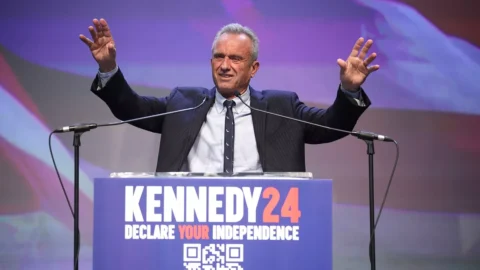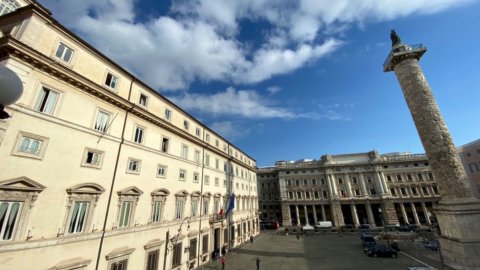This week with the Professor Stefano Luconi, he teaches History of the United States of America in the department of Historical, Geographical and Antiquity Sciences of the University of Padua, we want to talk about the tradition of independent candidacies in the history of American presidential elections.
These frequent nominations have often gone largely unnoticed by world public opinion. In November electionsHowever, the independent candidate who has announced his desire to run for the White House is not an emeritus unknown to the international community.
Far from it, the name it bears is that of one of the best known political dynasties, perhaps the best known, in the United States. It's about Robert F Kennedy Jr, son of Robert who was murdered in Los Angeles in June 1968 during the Democratic primary campaign. He was probably on his way to winning them only to find himself facing the same candidate, Richard Nixon, whom his brother John had met and narrowly defeated in the elections of November 8, 1960.
We asked Professor Luconi for a brief account of the meaning and outcome of major independent candidacies and third-party experiences in American history.
...
Isn't the American political system a clearly two-party system and the race for the White House is a two-person duel like in Sergio Leone's films?
“We usually think of the American political system in terms of a bipartisan system centered on the opposition between Democrats and Republicans since 1856. In reality, this is not the case. Especially the elections for the White House see a swarm of independent candidates and aspiring presidents representing minor parties. This year Robert F. Kennedy Jr. reminds us of this, having hit the headlines also in the Italian media above all due to the weight of his surname. Grandson of President John F. Kennedy and third son of Senator Robert F. Kennedy, after considering challenging Joe Biden for the Democratic nomination, he preferred to avoid the primaries to take the field directly in November as an independent".
But Kennedy Jr. was certainly not the first to intrude among the official candidates of the two parties, was he?
“Kennedy Jr. is just the tip of the iceberg. In 2016, in addition to Donald Trump and Hillary Clinton, there were 28 presidential candidates. Four years ago, there were as many as 36, including Biden and Trump. In some cases the candidatures were eccentric to say the least."
Eccentric in what sense?
“For example, in 2016, Rod Silva, the owner of a restaurant chain, ran at the head of the nutritionist party, with a program focused on measures to address health problems caused by poor nutrition, obtaining just 751 popular votes. In 2020, the rapper and record producer Kanye West, already a Trump supporter, invented his own political formation, the Birthday Party, advocate of a vague "culture of life", with which he obtained just over 66.000 votes".
Is there something beyond these Wes Anderson figures, who are never missing in any self-respecting election?
“Less bizarre people and parties have managed to gain an appreciable and long-lasting following over time. In particular, the libertarian party - founded in 1971 to reduce the functions of the federal government, cut taxes, eliminate the few forms of regulation of the US economy and expand civil liberties - received almost 2 million votes in 2020 and more than 4 million in 2016."
Is there an institutional barrier to running for President of the United States?
"Certain. The biggest problem for independent candidates and smaller parties is meeting the minimum requirements to be included on the ballot paper. In addition to paying a registration fee, it is necessary to deposit in each state a number of signatures in support of the candidacy equal to a percentage, which varies according to the different state provisions, of the valid votes cast in previous elections, sometimes with minimum thresholds to be reached in individual counties. This procedure requires having an organizational structure present in a widespread manner in the 50 states of the Union and is particularly burdensome. It was justified by the Supreme Court to avoid "frivolous and fraudulent" nominations, but in reality it was desired by Democrats and Republicans to limit challenges to their oligopoly on political life."
That's a pretty big barrier.
"It is. In 1992, Texan entrepreneur Ross Perot emerged as an independent candidate in all the states thanks to the millions of dollars of his considerable fortune (estimated at $3,3 billion, about $5,9 billion today) that he poured into collecting signatures . But small parties generally do not have these resources and, therefore, manage to present themselves only in a few states, compromising their chances of victory from the start. For example, among the 36 White House candidates in 2020, just three (Biden, Trump and Jo Jorgensen of the Libertarian Party) were on the ballot in all states and the District of Columbia.”
Are there any additional obstacles for aspiring independents?
“The majoritarian system for allocating electors on a statewide basis is another significant obstacle that significantly limits the ability of independents and third parties to compete. In 1992, Perot, despite having received 18,9% of the popular vote nationwide, always placed second or third in individual states, after Democrat Bill Clinton and Republican George HW Bush, and therefore did not win any major elections. voter".
Has there been any independent force that has had an appreciable result at the national level?
“The most successful third parties after the Second World War were those that became spokespersons for regional issues because they were able to concentrate their following in specific states, rather than distributing it more or less homogeneously at a national level, and on these issues they represented a concrete alternative to the Democrats and Republicans in these individual realities. This was demonstrated above all by the political forces that were the expression of white supremacism and of the will of the electorate of European ancestry in the South to maintain racial segregation in force after the Second World War".
Can you cite a few cases of a white supremacist candidate who has shown some following:
“In 1948 Strom Thurmond, candidate of the racist States' Rights Party, which arose in controversy with the openings of Democratic President Harry S. Truman towards the rights of African Americans, received 2,41% of the popular vote but obtained 39 electoral votes because he won the majority in four states of the Deep South (Alabama, Louisiana, Mississippi and South Carolina). Instead, in the same year, Henry A. Wallace – leader of a progressive party which, at the height of the Cold War, proposed the continuation of the alliance with the Soviet Union which had allowed the defeat of Nazi-fascism – obtained 2,37% of the vote popular which, distributed uniformly in all the States, did not allow him to assign any electoral votes".
If I'm not mistaken, in more recent times there was also another Wallace, governor of Alabama, who we have seen in some films and documentaries on the racial issue.
“In line with Thurmond's result and in contrast to that of Perot, in 1968 another openly racist candidate strong in the South, George Wallace – who had harshly contested Democratic President Lyndon B. Johnson's support for the granting of full civil rights and politicians to African Americans – received 46 electoral votes despite having 13,5% of the popular vote nationwide.”
A considerable achievement by George Wallace. Many are wondering today who Robert F. Kennedy Jr. will get votes from.
“In fact, one of the analysts' questions regarding Robert F. Kennedy Jr. is whether his candidacy will take votes away from Trump, due to his "no vax" positions, or from Biden, due to his family heritage which would place him among the progressives, although the Kennedy clan has openly dissociated itself from his campaign. Likewise, one wonders whether his candidate for vice president – the thirty-eight-year-old lawyer Nicole Shanahan, involved in the field of new technologies – will be able to win from Biden a significant number of young voters inclined to use these tools”.
Is Robert F. Kennedy Jr.'s candidacy essentially a disruptive candidacy or does he really interpret a trend among the electorate?
“Those of independents and third parties, in fact, are usually presented as disruptive candidacies. From this perspective, Perot made Clinton's election possible in 1992 with just 43% of the popular vote because, with his conservative positions (balancing the budget, welfare cuts, fight against drugs, economic nationalism), he would have drained votes by Bush Sr. Similarly, in 2000 the defeat of the Democrat Al Gore in Florida by only 537 popular votes and consequently in the electoral college was attributed to the hemorrhage of environmentalists towards the Green Party candidate, Ralph Nader, which in Florida led to house over 97.000 votes”.
Can it be a real alternative to the political offer of the two major parties?
“This is not the only possible interpretation of “disturbance”. After eight years of Clintonian moderatism, which had brought the Democratic Party closer to the positions of the Republicans, Nader brought disillusioned progressive voters to the polls who, in the absence of an alternative, would not have gone to vote in 2000. The black candidate Cynthia McKinney of the Green Party in 2008 he collected the votes of two groups who did not identify with the political offer of the two major parties and, therefore, would have otherwise been inclined to abstain: some African Americans, dissatisfied with the Bush Jr. administration and even more so with the post-war attitude - Barack Obama's racial bias in the election campaign, and the pacifists, who accused the Democratic candidate of having latched onto the war-mongering positions of the Republicans due to the belief that the "war on terrorism" should simply be recalibrated with a shift in the terrain of military operations from Iraq to Afghanistan."
In American electoral history there was also the "anomalous" case of Theodore Roosevelt.
“In this case, the third force of the moment proved much more popular than either of the two major parties. In 1912, former Republican President Theodore Roosevelt, displeased with the conservative policies of his successor in the White House, William Howard Taft, even though he himself had helped him run for his seat in 1908, challenged him as leader of a newly formed progressive party. The victory in the race for the White House went to Democrat Woodrow Wilson. But Roosevelt decisively prevailed over Taft, garnering more than 4 million popular votes and 88 electoral votes compared to the less than 3,5 million popular votes and just 8 electoral votes that went to the incumbent president.”
Twelve years later, however, the attempt by a third party resulted in a sensational fiasco.
“In 1924, at the head of a new progressive party that called for the nationalization of railroads and hydroelectric plants and a tightening of antitrust regulations, Robert M. LaFollette tried to wrest enough states from Democrat John W. Davis and Republican Calvin Coolidge so that no one obtained a majority in the electoral college and the choice of president passed to the House, where he believed he had a chance of success. But LaFollette won only in his own state, Wisconsin, and Coolidge was elected by a wide margin.”
In the vast majority of cases the alleged disruptive function of third party candidates did not have any major effects on the outcome of the elections, did it?
“It is a reality that the disruptive function of third parties has often proven to be illusory. McKinney did not hinder Obama's victory in 2008 nor did the presence of an independent conservative, John B. Anderson, turn the 1980 election into a head-to-head between Republican Ronald Reagan and Democrat Jimmy Carter, as some observers had instead speculated: Reagan triumphed in 44 out of 50 states."
...
Stefano Luconi teaches History of the United States of America in the Department of Historical, Geographical and Antiquity Sciences at the University of Padua. His publications include The “indispensable nation”. History of the United States from its origins to Trump (2020) US institutions from the drafting of the Constitution to Biden, 1787–2022 (2022) and Lthe black soul of the United States. African Americans and the difficult path to equality, 1619–2023 (2023)
Books:
Stefano Luconi, The race for the White House 2024. The election of the president of the United States from the primaries to beyond the vote on November 5, goWare, 2023, pp. 162, €14,25 paper edition, €6,99 Kindle edition
Stefano Luconi, US institutions from the drafting of the Constitution to Biden, 1787–2022, goWare, 2022, pp. 182, €12,35 paper edition, €6,99 Kindle edition





